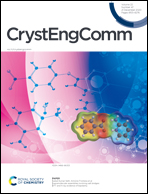Protection of highly active sites on Cu2O nanocages: an efficient crystalline catalyst for ammonium perchlorate decomposition†
Abstract
For crystalline catalysts with special morphology, the corners and edges are usually of high activities due to the presence of unsaturated coordination sites, so it will be an ideal strategy to promote catalytic properties by only keeping the corners and edges of such kinds of catalysts. In this work, a Cu2O tetradecahedral nanocage with plenty of corners and edges was formed by selectively etching the (111) and (100) facets on the basis of a simple top-down method, in which SDS was used as a protective agent to keep the active corners and edges while hydroxylamine hydrochloride was used as a reducing agent and an etchant. The decomposition of ammonium perchlorate (AP) was used as a probe reaction to test its catalytic performance. It was found that the low temperature decomposition (LTD) and high temperature decomposition (HTD) were reduced by 27.1 °C and 107 °C, respectively, and the heat release increased by three times in comparison with pure AP. The Cu2O nanocage exhibits excellent activity and high catalytic performance in the reaction. This work provides us an effective AP thermal decomposition catalyst and a simple strategy to fabricate a hollow structure with low-energy facets etched and highly active facets exposed.



 Please wait while we load your content...
Please wait while we load your content...